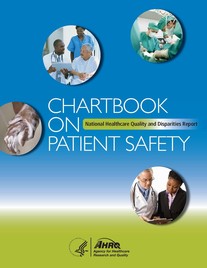| February 9, 2021, Issue #750 Among people who lived in the direct path of a hurricane between 2005 and 2016, people age 65 years and older had the highest rate of injury-related emergency department visits resulting in hospital admission (53 percent) during the week of the hurricane. (Source: AHRQ, Healthcare Cost and Utilization Project Statistical Brief #267: Impact of Hurricanes on Injury-Related Emergency Department Visits, 2005-2016.) An analysis of the nation's primary care practices revealed that 17 percent received no revenue from Medicaid, and fewer than half received "high" revenue (more than 10 percent of the practice's total revenue) from the insurance program. The study, funded via AHRQ's Comparative Health System Performance Initiative, found that practices receiving no Medicaid revenue were more often small, independent and located in urban areas with higher household income; tended to have a higher proportion of primary care physicians in their practices; and had lower scores on population health measures. Access the abstract of the study, published in Health Affairs.  AHRQ has released the Chartbook on Patient Safety, a data resource that shows recent gains in safety include declining rates of urinary tract infections and pressure ulcers in nursing homes. Despite those improvements, safety-related disparities persist in several areas of care. In 2017, for example, high-risk Black patients in long-stay nursing homes were more likely than Whites to have a pressure ulcer (7.2 percent vs. 4.3 percent). In addition to nursing home data, the chartbook describes safety trends in hospital, ambulatory and home health settings, as well as trends related to communication and the use of safety tools and resources. Like other chartbooks, the publication draws from data in AHRQ's annual National Healthcare Quality and Disparities Report. Previous chartbooks provided data on care coordination, access to care, care for Blacks and healthy living. |  The five-star rating system used by the Centers for Medicare & Medicaid Services (CMS) to assess the overall quality of Medicare Advantage (MA) contracts captures key domains of health plan quality, such as using higher-quality hospitals and having fewer hospital readmissions, according to an AHRQ-funded study in Health Affairs. Researchers looked at experiences of 16 million MA enrollees in 515 contracts; of those, 1.3 million enrollees in 42 contracts were involved in a contract consolidation. They found that enrollees who switched to more highly rated MA plans due to a contract consolidation were 3.4 percent more likely to use a higher-quality hospital, and 2.6 percent less likely to be readmitted within 90 days. While CMS reimburses MA plans for higher-quality care, some of that is due solely to contract consolidations and should be re-evaluated with more cost-effective and targeted measures, the authors concluded. Access the abstract. |  A new AHRQ issue brief suggests that health information technology tools such as online patient portals, mobile text messaging and health apps may offer new opportunities to involve patients and improve diagnoses made in emergency departments (ED). For example, access to patients' primary health care portals during ED visits may allow patients and providers to review medical records in real time, view previous test results and access additional clinical details. Patients discharged from an ED without a definitive diagnosis can share ED provider notes and diagnostic testing with their primary care provider. Mobile text messaging may be used to engage patients in follow-up planning and encourage treatment adherence. Access the issue brief. | AHRQ's Patient Safety Network (PSNet) highlights journal articles, books and tools related to patient safety. Articles featured this week include: Review additional new publications in PSNet's current issue or access recent cases and commentaries in AHRQ's WebM&M (Morbidity and Mortality Rounds on the Web). | AHRQ in the Professional Literature Antibiotic overuse after hospital discharge: a multi-hospital cohort study. Vaughn VM, Gandhi TN, Chopra V, et al. Clin Infect Dis. 2020 Sep 11. [Epub ahead of print.] Access the abstract on PubMed®. Pediatric sepsis in community emergency care settings: guideline concordance and outcomes. Greenwald E, Olds E, Leonard J, et al. Pediatr Emerg Care. 2020 Oct 1. [Epub ahead of print.] Access the abstract on PubMed®. Identifying the fundamental structures and processes of care contributing to emergency general surgery quality using a mixed-methods Donabedian approach. Santry HP, Strassels SA, Ingraham AM, et al. BMC Med Res Methodol. 2020 Oct 2;20(1):247. Access the abstract on PubMed®. The value of decreasing the duration of the infectious period of severe acute respiratory syndrome coronavirus 2 (SARS-CoV-2) infection. Lee BY, Bartsch SM, Ferguson MC, et al. PLoS Comput Biol. 2021 Jan 7;17(1):e1008470. Epub 2021 Jan 7. Access the abstract on PubMed®. The impact of paid family leave in the United States on birth outcomes and mortality in the first year of life. Montoya-Williams D, Passarella M, Lorch SA. Health Serv Res. 2020 Oct;55(Suppl 2):807-14. Epub 2020 Apr 5. Access the abstract on PubMed®. Impact of the COVID-19 pandemic on healthcare workers' risk of infection and outcomes in a large, integrated health system. Misra-Hebert AD, Jehi L, Ji X, et al. J Gen Intern Med. 2020 Nov;35(11):3293-301. Epub 2020 Sep 1. Access the abstract on PubMed®. Reports of forgone medical care among US adults during the initial phase of the COVID-19 pandemic. Anderson KE, Mcginty EE, Presskreischer R, et al. JAMA Netw Open. 2021 Jan 4;4(1):e2034882. Access the abstract on PubMed®. Trends in poor health indicators among Black and Hispanic middle-aged and older adults in the United States, 1999-2018. Odlum M, Moise N, Kronish IM, et al. JAMA Netw Open. 2020 Nov 2;3(11):e2025134. Access the abstract on PubMed®. Contact Information For questions or comments about AHRQ News Now, contact Bruce Seeman, (301) 427-1998 or Bruce.Seeman@ahrq.hhs.gov. |





No comments:
Post a Comment